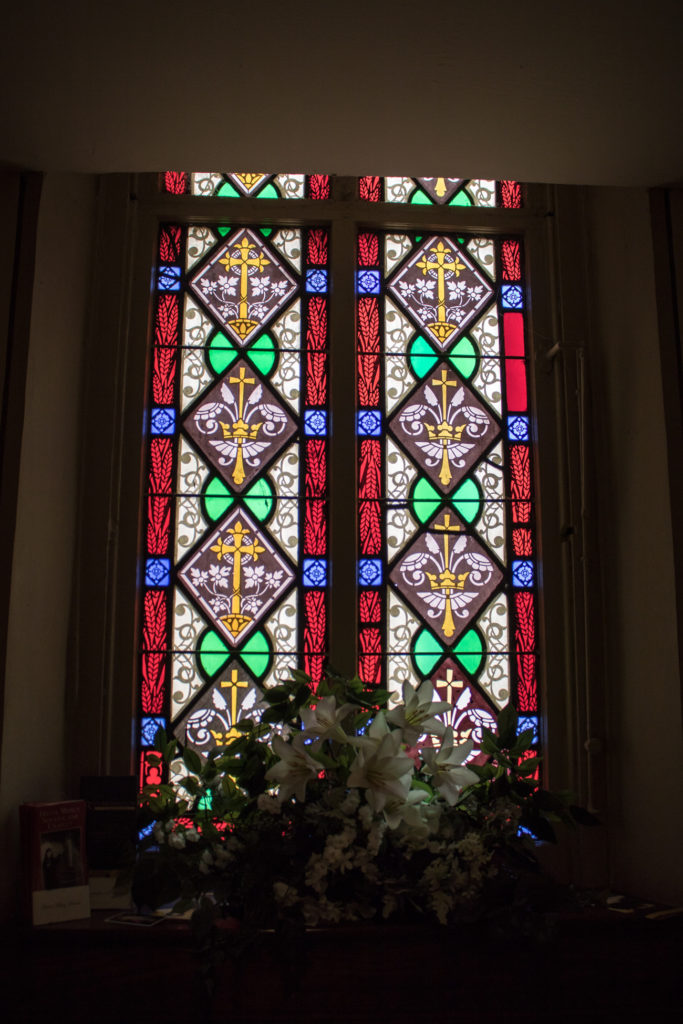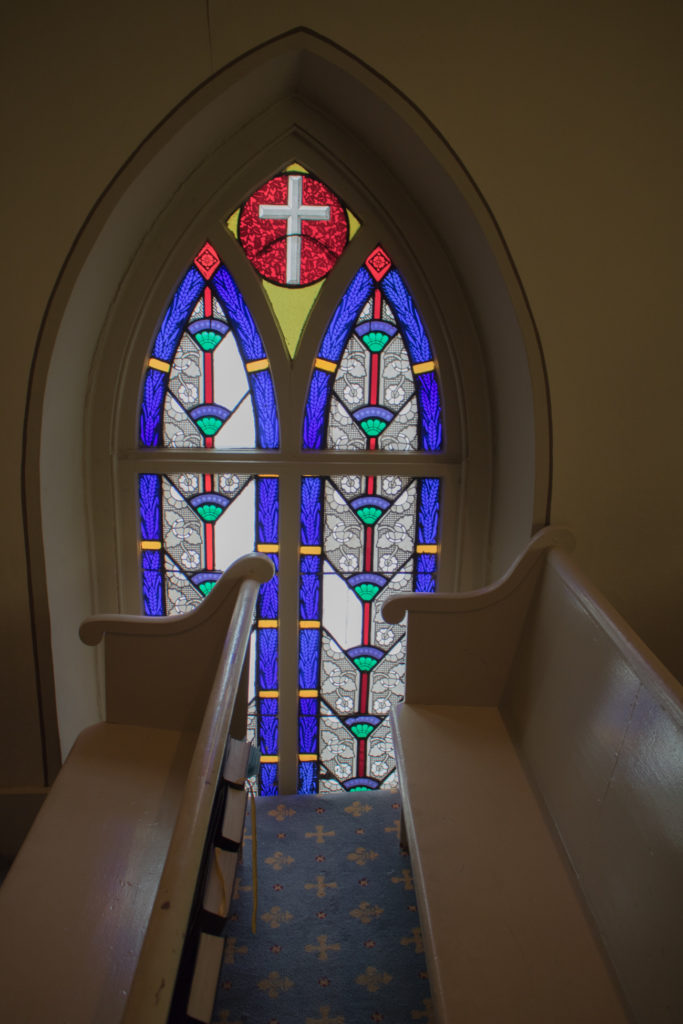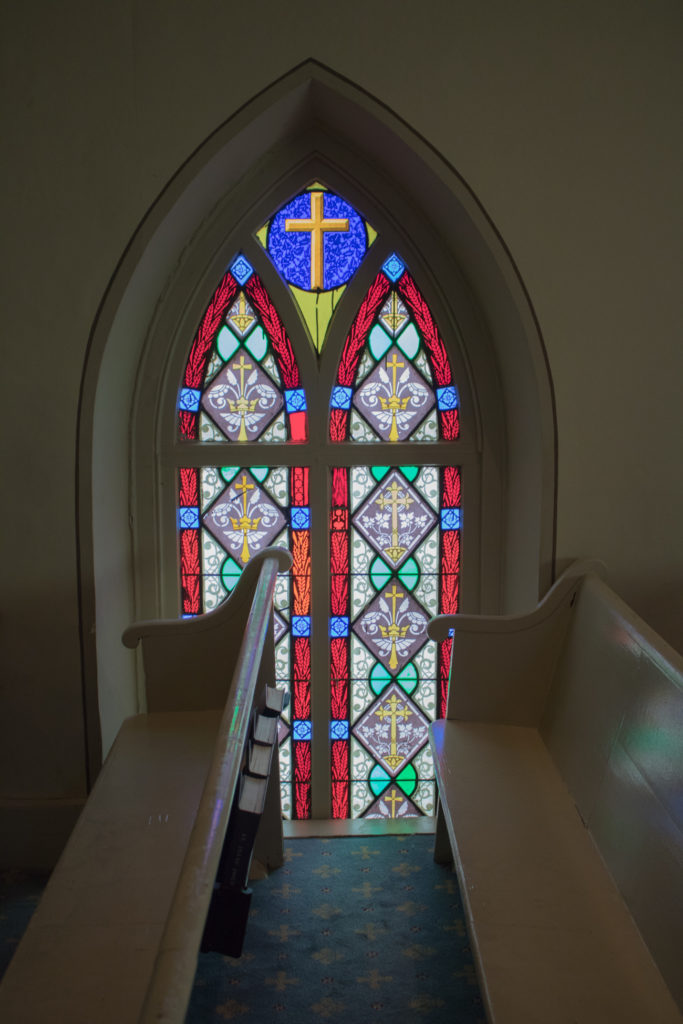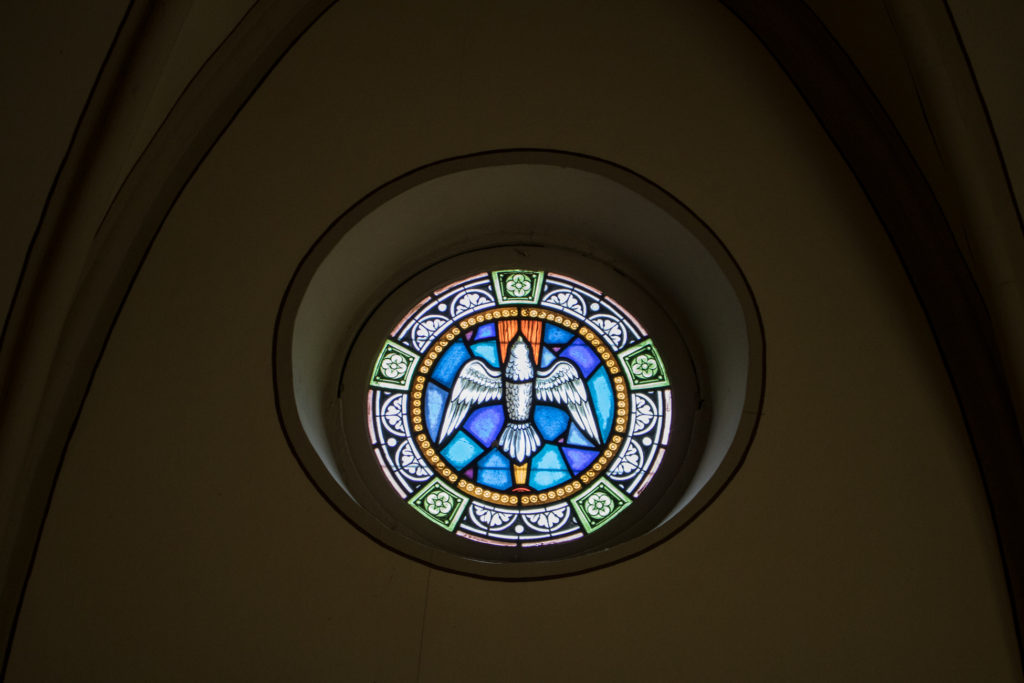Beautiful stained glass windows in the historic Basilica of Saint Mary are among the most striking features of the Basilica. Their artistic and symbolic meaning have inspired countless parishioners and visitors for over 190 years since the building of the church at South Royal Street.
Stained glass windows graphically catechize the devout faithful while memorializing many of the parish founders. In the earliest days of the parish, windows helped educate and inspire parishioners, some of whom were illiterate, or may not have had access to Bibles or other books. Depicting Our Blessed Lord, scenes from Sacred Scripture and images of the Saints, the stained glass presents colorful “windows into Heaven”. While bringing light into the church, these windows impart a supernatural quality, appropriate to the space in which the Lord Jesus in His Real Presence resides, and where the Holy Sacrifice of the Mass is offered.
Artisans and glass makers from Germany and the United States made the windows in the late nineteenth-century. Most of the windows were the work of the Herman T. Gernhardt Glass Company of Baltimore, Maryland. Many of the more recent windows were designed by New York ecclesiastical artist Francis Sturm. Many of the windows were installed approximately 60 years after the Narthex of the Royal Street church was built, for the commemoration of the parish Centenary in 1895.
The oldest windows are those closest to the Sanctuary, installed when the church was remodeled by Reverend Father Henry J. Cutler in 1895. Others were added at various times in the early twentieth-century and following the great fire of 1929. In 1948, the Monsignor Edward L. Stephens (1943-1959 ) added five windows: the four in the choir loft, commemorating the North American Martyrs, and the window depicting Jesus and Nicodemus in the former baptismal niche near the church entrance. The addition of these windows and the great crucifix in the Sanctuary in the period following World War II had great meaning for the parishioners of the Basilica of Saint Mary.
Windows that appoint the church have been designed in three distinct styles:
- Large Panel Windows (single or double) with operable lower casements. Large and smaller panel windows depict the life of Our Blessed Lord, His Holy Mother and Saint Joseph, as well as accounts from Sacred Scripture. The bottom panels (many of which are still operable and open for ventilation) memorialize the priests and faithful who contributed generously to the building of the parish.
- Slender Lancet Windows (single or double) of decorative motifs in regular patterns. These have been used in lofts, in small niches, and in stairwells of the church. They often consist of elaborate patterns, some more geometric and others more natural forms incorporated into regular patterns. Often they have traditional motifs, including acanthus, cross, crown, or fleur-de-lis motifs.
- Round Oculus Windows located in the Sanctuary and in the upper regions of the Nave and Transepts. Oculus windows depict religious symbols representing the Saints, Holy Mother Church and Her Sacramental Life.
Floor plans with the windows have been numbered sequentially, beginning with the windows in the North Nave, progressing into the North Transept Loft, the Sanctuary, the South Transept Loft, the South Nave, and finally ending in the Choir Loft of the basilica. Each of the windows are identified on the plans that precede their descriptions. Photographs at the end of this page provide the images of the basilica in more comprehensive views. Large Panel Windows are indicated with a “W” followed by the number. The Round Oculus windows are indicated with an “O” followed by the number.
Floor Plans
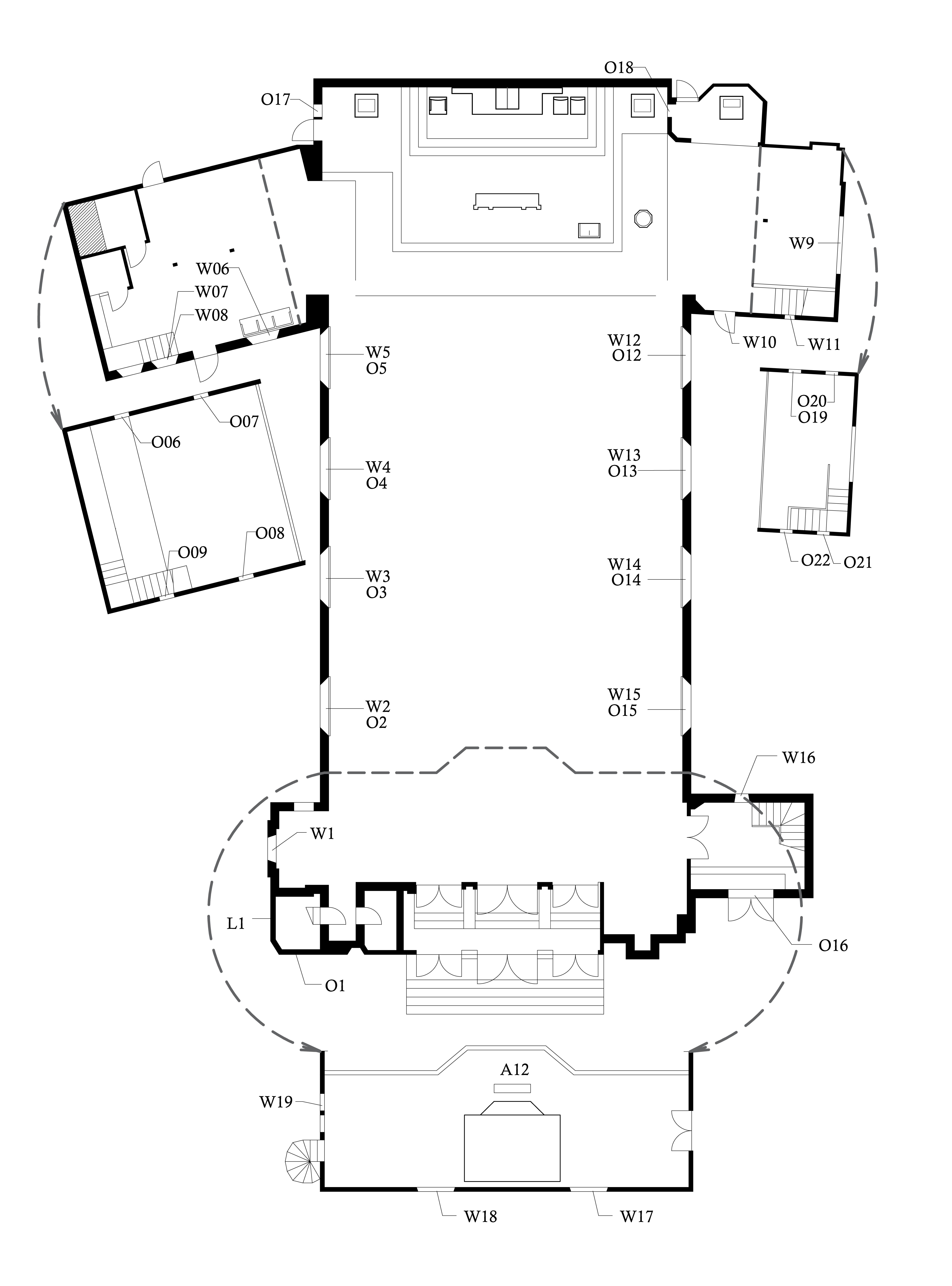

O1 – Quatrefoil Window
Located inside the North Tower Stairwell is the window depicting a quatrefoil motif. This appears to be a more contemporary replacement of an earlier window that would have dated back to the 1896 construction of the Tower by Reverend Father Henry J. Cutler (1891 – 1915), before the introduction of electric lighting in the church.
L1 – Narrow Lancet Windows
This series of four narrow lancet window is located in the stair tower leading to the choir loft. The windows are less than one-food in width, consisting of banded diamond patterned stained glass. They provide natural light to the North Tower added by Reverend Father Henry J. Cutler in 1896, before there was electric light in the church.

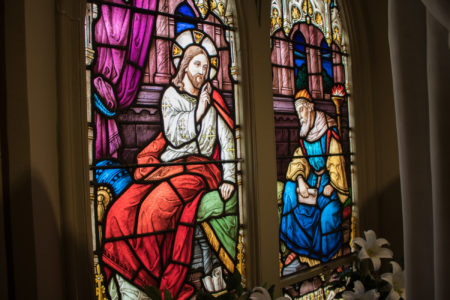
W1 – Jesus and Nicodemus (John 3:1-21)
Located in what originally served as the basilica baptismal niche (now the site of the statue of St. Thomas More), this window depicts Nicodemus visiting Jesus to discuss His teachings, including being “born again” in baptism. Dedicated in memory of Annie V. Nugent (1877-1936) who served as both the organist and choir director for many years. Her donation to the church enabled the purchase of a new pipe organ in 1985.
 W2 – Jesus and Saint Margaret Mary Alacoque
W2 – Jesus and Saint Margaret Mary Alacoque
In His appearances to this French Visitation nun (1647-1690), Jesus asked Saint Margaret Mary to promote devotion to His Sacred Heart. To validate her story, a priest instructed Margaret Mary to ask Jesus what he, the priest, said in his last confession. She reported back that Jesus said, “I don’t remember.” This proved correct because Jesus forgives, but then forgets, our sins. This window was dedicated in 1905 in memory of Alexandria businessmen Henry Egan and J.J. Walsh and Relatives.

O2 – The Mystical Rose (Litany of Loretto)
The White Rose on a red eld is surmounted with a starburst of golden rays around the AM monogram signifying “Ave Maria”. Locating the Mystical Rose, one of the many titles of the Blessed Virgin Mary above the window depicting the Sacred Heart appearance to Saint Margaret Mary Alacoque has particular significance. As a very young woman, Margaret Mary became paralyzed and was confined to bed for four years. The saint consecrated herself to the Blessed Virgin Mary for religious life, at which time she was immediately restored to health. This recalls the Beatitude: “Blessed are the pure of heart, for they shall see God.” (Matt. 5:8).
 W3 – Saint Helena and Our Lady of Perpetual Help
W3 – Saint Helena and Our Lady of Perpetual Help
Saint Helena (250 – 330 AD) was the mother of Constantine the Great, Emperor of Constantinople, who ended persecution of Christians. At the age of 80, Helena discovered the three crosses in Jerusalem. Only one of the three had the power of Jesus to cure a sick woman, revealing it as the True Cross. In the window of Our Mother of Perpetual Help, Our Lady is shown with her Royal Crown, holding the Child Jesus, who has just envisioned His future Crucifixion. She is comforting Jesus while reaching out to remind us she is there when we need her help. Donated in memory of Mr. and Mrs. Edward Quinn, Irish immigrants.

O3 – The Golden Chalice
Marked with a cross, the chalice is presented against a red eld, symbolic of the Precious Blood. White grapes and wheat surround the Chalice, which is surmounted by a Host, also embossed with a Cross. Symbols of the Holy Eucharist with the Cross imprints are particularly significant in this location, directly above Our Lady of Perpetual Help and Saint Helena, whose devotion to Our Blessed Lord was so great and powerful.
 W4 – Saint Bridget and Saint Patrick
W4 – Saint Bridget and Saint Patrick
These two well-known Irish Saints, Patrick and Bridget (both around 400-500 AD), are depicted in this prominent location in the center of the Nave. Saint Patrick converted the Irish to Christianity, and Saint Bridget founded a convent so many young girls could become nuns. The window as given to the Church of Saint Mary by the family of Denis and Ellen Buttimore, founding members of the parish and Irish immigrants from County Cork.

O4 – Keys of the Kingdom
Symbolizing Saint Peter and the Papacy, the keys of apostolic succession are shown above this courageous Bishop and the two co-patrons of Ireland. In addition to commemorating the many Irish clergy who served at the Church of Saint Mary, this also bears witness to all the parishioners of the past two centuries who stood in solidarity with the Popes, with their Bishops, and with their Priests against the errors and the persecutions of their day.
 W5 – Saint Vincent de Paul and Saint Michael the Archangel
W5 – Saint Vincent de Paul and Saint Michael the Archangel
The window depicting Saint Vincent de Paul (1580-1660), Patron Saint of the Poor, was donated by the family of Michael A. Ahern, son of Irish immigrants. Mr. Ahern was an active member of the parish Saint Vincent de Paul Society and left most of his estate to the Society and other charities. The Saint Michael half of the window reflects the fact that Mr. Ahern s baptismal name was Michael. The archangel is holding a sword with a flame, representing his role as our protector against the wickedness and snares of the devil.”

O5 – Sacred Heart of Jesus
This window symbolizes the Sacred Heart of Jesus, as described by Saint Margaret Mary Alacoque. Our Lord told Saint Margaret Mary that the flames represented His love for humanity, and the thorns represented man’s sinfulness and ingratitude. Jesus revealed twelve promises that He would bestow upon all those who practice the devotion. This location is particularly appropriate for the Sacred Heart, above the window of Saint Vincent de Paul, whose incorrupt heart remains with the Convent of the Sisters of Charity in Paris. Both the mortal Saint Vincent and the Angelic Saint Michael defended the honor of God against the evils of their times.
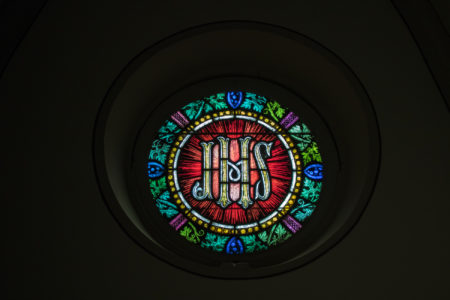
O6 and O7 – The “IHS” Symbol
Many of the churches founded by the Society of Jesus (the Jesuits) use the IHS Symbol (Iesus Hominust Salvator). The two windows located on the East Wall of the North Transept Loft present two representations of this same monogram. Oculus Window 6 depicts the monogram intertwined around a gold Roman cross (representing the I of the IHS) and a large white S against a royal blue eld. The surrounding wreath of red grapes and green leaves is punctuated with crosses in red insets. Oculus Window 7 represents the “IHS” on a red emblazoned background, surrounded with a wreath of leafy vines. Both windows attest to the Jesuit foundations of the church dating back to 1795 under the patronage of Archbishop John Carroll of Baltimore, a member of the Society of Jesus, who relinquished his membership in the Order after being appointed the First Archbishop of Baltimore, the First See for the United States of America and the Basilica of Saint Mary’s connection as the “eldest daughter” of Trinity Church at Georgetown University.
O8 and O9 – Two more oculus windows are located on the West Wall of the North Transept Loft. The Holy Spirit Ascending and the Blue Cross Flitchy appear to date to different times in the Basilica’s history, with
the Holy Spirit being the older of the two windows. The Cross Flitchy with its pointed ends is an ancient symbol, used in British or French armory.
W9 – Saint Edward the Confessor and Saint Louis of France
These windows date to the 1950s, and were originally installed at the IHM Convent Chapel, adjacent to Saint Mary’s School. The image of Saint Edward is dedicated to the memory of Reverend Monsignor Edward L. Stephens, (Pastor, who was responsible for major renovations of the Basilica of Saint Mary after World War II). Monsignor Stephens was responsible for the publication “St. Mary’s: 150 Years for Christ” which documented the history of the church up to the year 1945. The image of Saint Louis is dedicated to the memory of Reverend Father Louis Smet, (Pastor, 1915 – 1927). A noted theologian and professor, Father Smet returned to his native Belgium to serve as the Vice Rector of the American College in Louvain. The upper portion of these window consists of a gothic arch, dedicated In Memory of All Mothers. Reverend Father Stanley Krempa (Pastor, 1991 – 1999) relocated these windows from the Convent Chapel when the building was converted to the junior high school and renamed “Stephens Hall” in honor of Monsignor Stephens.
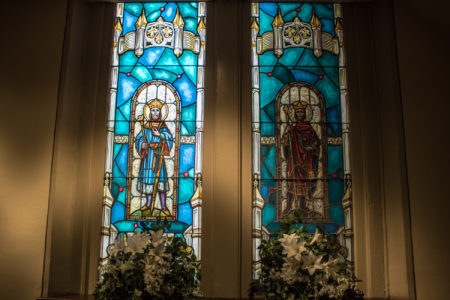
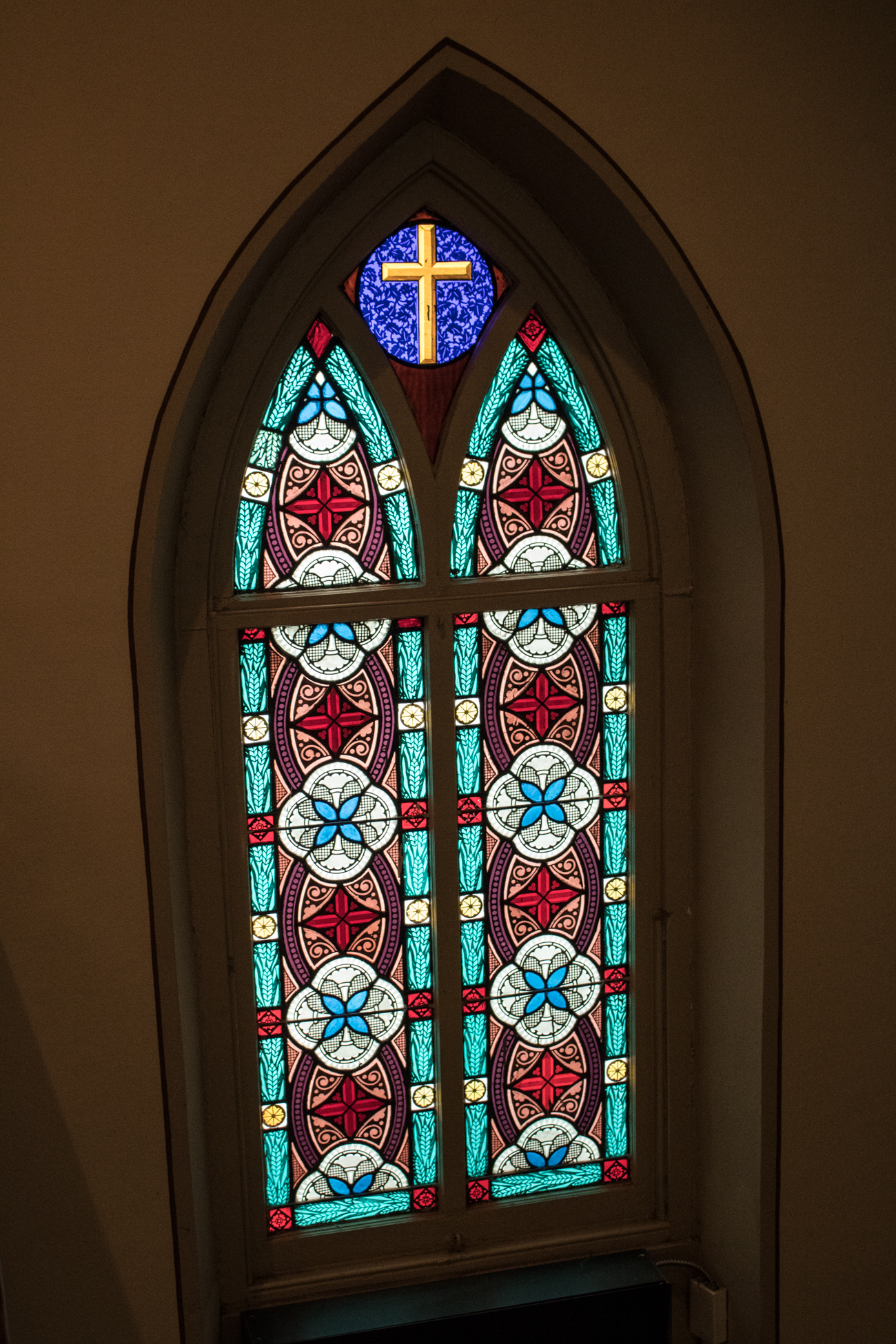 W10 – W11 Decorative Double-Patterned Windows:
W10 – W11 Decorative Double-Patterned Windows:
Two patterned stained glass windows grace the West Wall along the stairwell to the South Transept Loft. The second is located above the exterior door to the South Garden and handicapped accessible ramp to South Royal Street. Beautifully detailed in double gothic arches, crown with an internal oculus depicting crosses, the windows are similar to those in the North Transept and Loft Areas.
O17 – Holy Spirit Descending as Dove
The dove is the symbol of the Holy Spirit, the Third Person in the Most Holy Trinity. It is also a symbol of peace because a dove brought Noah a bough of an olive branch as a sign the flood has ended. This window image echoes the painted image above the altar of the Holy Spirit. Its placement just above the traditional location for the statue of Saint Joseph is particularly poignant to the parishioners. Saint Joseph was the just man who listened to the Word of God and was obedient to the promptings of the Holy Spirit and the angelic messengers who came to him in dreams. Although Scripture does not record the words of this powerful intercessor, his actions in protecting the Blessed Virgin Mary and the Child Jesus speak volumes to the faithful of all times and in all places.
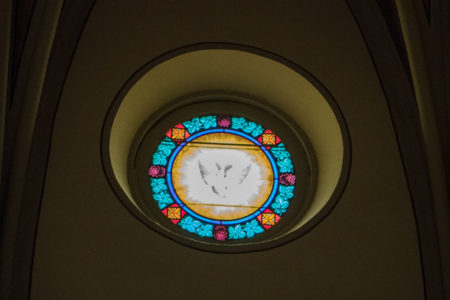

O18 – The Immaculate Heart of Mary
Pierced by the sword and encircled with roses, the Oculus Window of the Immaculate Heart has been installed just above the historic location of the statue of Our Lady of Sorrows. In this church dedicated to Our Blessed Lady, she stands at the foot of the Cross quite literally, with the sword piercing her Immaculate Heart. Symbolically, Mary’s Immaculate Heart triumphs, even in the most difficult of circumstances.
O19 – Large Sheaf of Wheat
Among the older oculus windows, this depicts the large sheaf of wheat, the matter required for the confecting of the Most Blessed Sacrament. It also recalls the passages from the Old and New Testament about the gathering of the harvest.
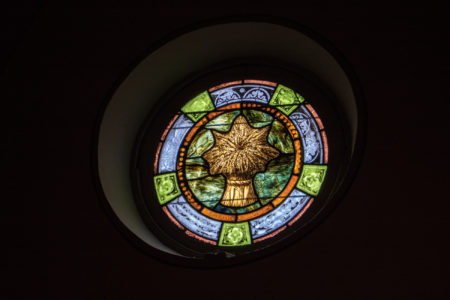
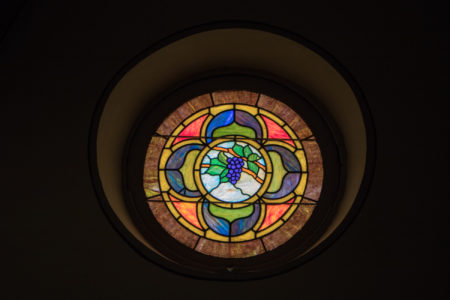
O20 – Cluster of Grape
Among the few modern replacement windows in the basilica, this window presents the grapes required to make the wine, to be confected into the Precious Blood of the Lord. It also recalls the parables of Our Blessed Lord about the vine and the branches, recalling His words “without me, you can do nothing.”
O21 – “AM” Monogram
Located on the West Wall, the “AM” Monogram represents “Ave Maria” in gold initials, entwined around a white trefoil cross. This design motif signifies Our Lady s white martyrdom as she stood by the Cross, accompanying her Son on the “Via dolorosa.”

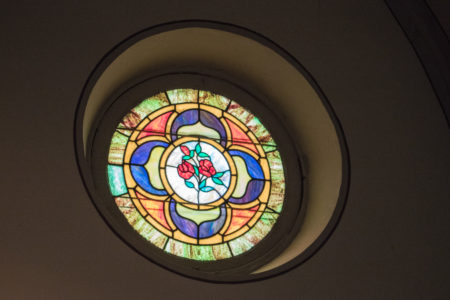
O22 – Mystical Rose
Similar in design to the O13 Oculus Window, this window is located opposite the Cluster of Grapes on the West Wall of the South Transept. It recalls the “Mystical Rose” which is one of the many titles of Our Blessed Lady from the Litany of Loreto.
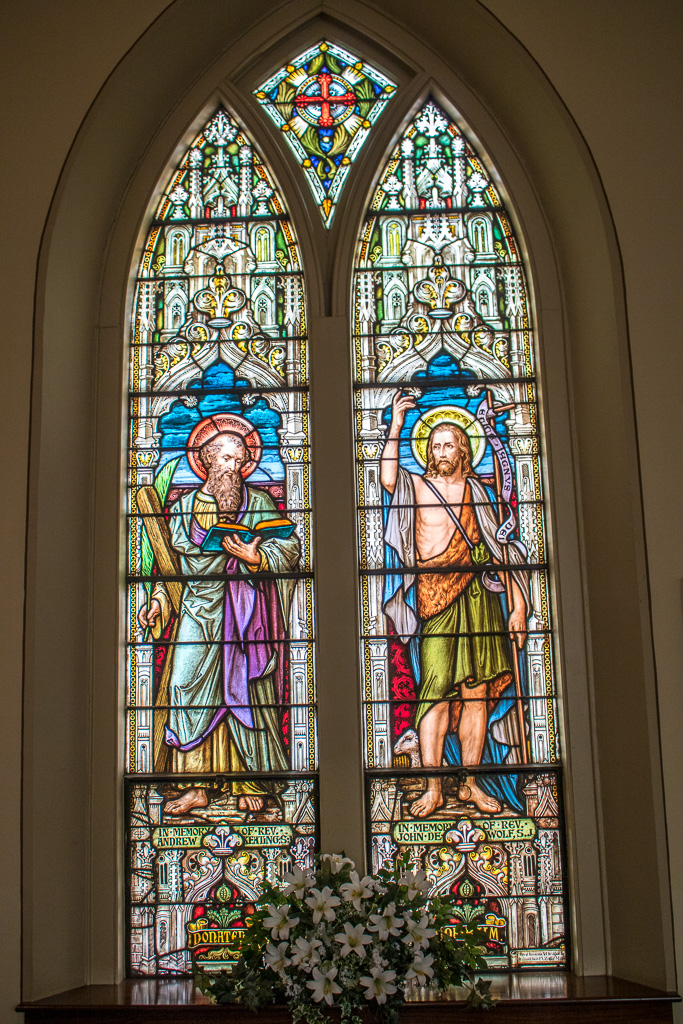 W12 – Saint Andrew the Apostle and Saint John the Baptist
W12 – Saint Andrew the Apostle and Saint John the Baptist
Both Saint Andrew and Saint John the Baptist led people to Jesus. Saint Andrew led his younger brother, Peter, to Jesus. Peter became an Apostle of Jesus, one of his most trusted friends and the first Pope of the Church. John the Baptist prepared people for the coming of Jesus, leading them to Him through baptism. The Saint Andrew window is dedicated in memory of Reverend Father Andrew Keating, S.J., a Jesuit from Wexford, Ireland, who served as Assistant Pastor (1875-1880). The Saint John the Baptist window is dedicated in memory of Reverend Father John de Wolf, S.J., Assistant Pastor (1881-1882) and a native of East Flanders (Holland). These two windows were donated by the Sodality of the Blessed Virgin Mary.

O12 – The Pelican Feeding its Young
The mother pelican pecks her chest and feeds her blood to her child, just as Jesus sheds His Precious Blood for us and feeds us in the Holy Eucharist. Both Saint Andrew and Saint John the Baptist were martyred for their adherence to the Faith. The placement of this window above their window is particularly symbolic of the self sacrificial life of the Christian.
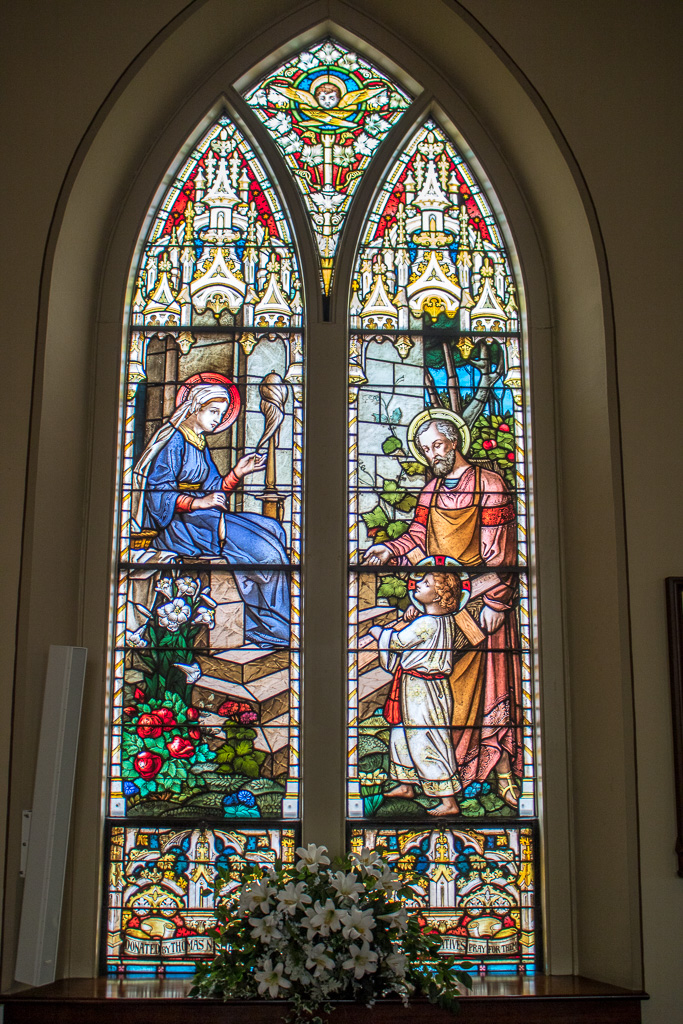 W13 – The Holy Family
W13 – The Holy Family
The depiction of the Holy Family shows Jesus as a young boy, learning from His father Joseph, perfecting the carpentry trade. Jesus is carrying the ruler (note the numbers on the sides), foreshadowing the wood of the cross He will carry to His crucifixion. Mary sews and watches Him. The red roses and white lilies at Mary’s feet symbolize her faithfulness and purity as well as her suffering. The apple tree in the background reminds us of the Tree of Knowledge and of Good and Evil. This window was dedicated in memory of Thomas N. Scott and family. Mr. Scott, originally from Ireland, owned a carpentry shop that worked on the church in 1883 when it was enlarged under the direction of noted local architect Philip N. Dwyer. He was also the contractor who built the Lyceum and was responsible for the 1894-1895 renovations of the church.
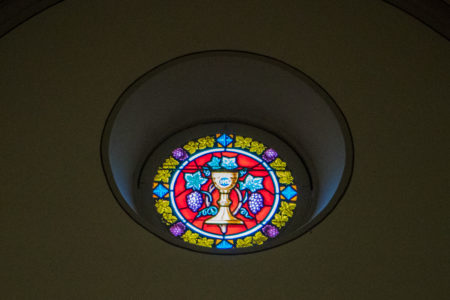
O13 – “IHS” Symbol with Chalice and Grapes
The image presents the Chalice embla oned with the monogram IHS against a red eld, symbolic of the sacri ce of the cross. Grapes and vines surround the Chalice of the Precious Blood of Jesus, Savior of all people. Both windows relate to the sacrifice of the Holy Family, doing the Will of the Father on earth for the redemption of mankind.
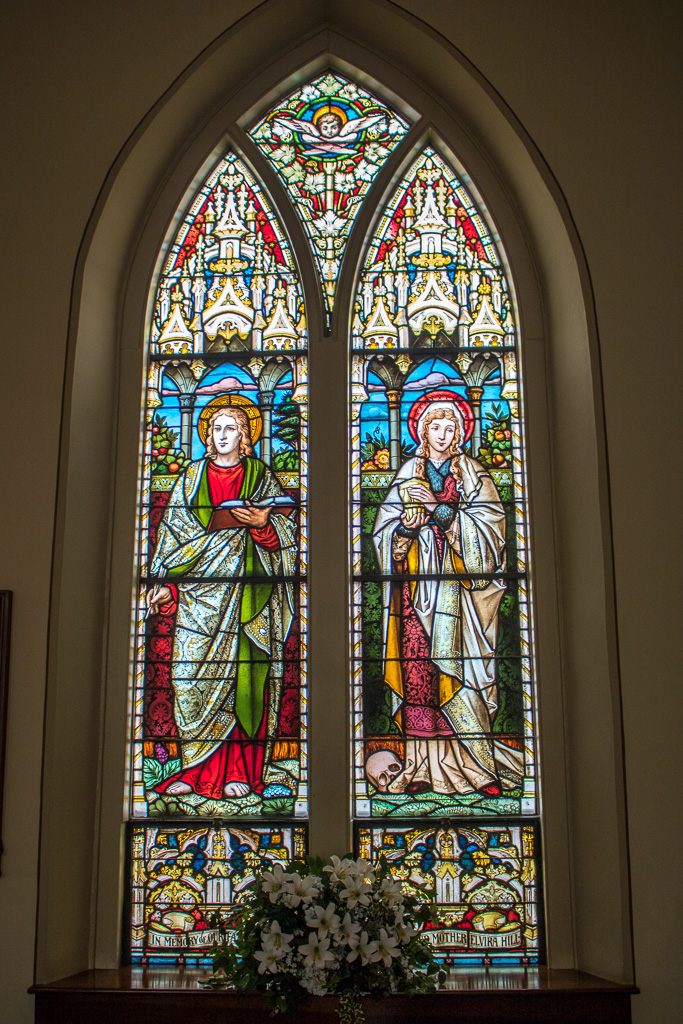 W14 – Saint John the Beloved and Saint Mary Magdalene
W14 – Saint John the Beloved and Saint Mary Magdalene
Saint John the Evangelist and Saint Mary Magdalene the two biblical figures in this window were the closest disciples of Our Blessed Lord. Saint John was known as the Apostle, the Evangelist, and the Beloved. He was the only Apostle at the foot of the cross during the crucifixion. Jesus entrusted the care of His Holy Mother to Saint John. Saint Mary Magdalene was a sinner, freed from seven demons by Jesus. In turn, she followed Him and was the first person to see Jesus after He rose from the dead. The skull by her feet represents this miracle at the Holy Sepulchre. The Hill Family donated this window in memory of Alexandria businessman John T. Hill and his wife Elvira.
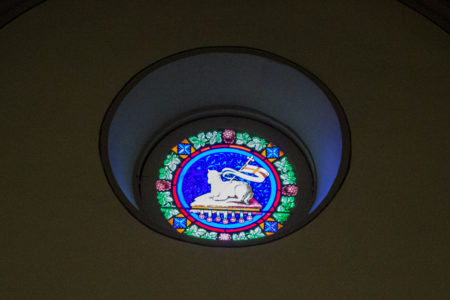
O14 – The Recumbent Lamb with Cross (Revelation 7: 9-17)
This window depicts the Lamb, recumbent on the Book of the Seven Seals with the Banner of Victory and Cross. This window symbolizes the sacrifice of Jesus and His victory over sin and death. It is appropriately placed above the figures of Saint John the Beloved and Saint Mary Magdalene, the two faithful disciples who attended to the Lord Jesus through His Sorrowful Passion, and are among the first to encounter Him after the Resurrection.
 W15 – The Lord Jesus with the Little Children (Luke 18: 15-17)
W15 – The Lord Jesus with the Little Children (Luke 18: 15-17)
This window illustrates Christ’s words in the Gospel of Mark and the Gospel of Luke: “Let the children come to Me, do not hinder them; for to such belongs the kingdom of God.” This window is dedicated in memory of Dr. Francis J. Murphy, MD (1812-1877), the son of Irish immigrants. He was known for treating everyone, regardless of their ability to pay, and he rarely billed patients for the cost of their medical care.

O15 – Tower of Ivory (Litany of Loreto)
The “Tower of Ivory” is among one of the great titles of Our Lady taken from the Litany of Loreto. It relates to the image of Jesus welcoming the little children, recognizing their dignity, their innocence and their purity. The window recalls the dignity, innocence and purity of souls who follow Our Blessed Lord and live the Christian Virtues.
 W16 – Saint Joseph and the Child Jesus (Inside Stairwell to Choir Loft)
W16 – Saint Joseph and the Child Jesus (Inside Stairwell to Choir Loft)
Depicted in a pose similar to the statue of Saint Joseph in the Sanctuary, this window presents the Foster Father of Jesus holding the Lily of Purity that is symbolic of his obedience to the Will of God. Joseph was the righteous man of faith, known as the “terror of demons” and “protector of Holy Mother Church.”

O16 – Keys of Saint Peter (above the South Tower Portal)
Symbolizing Saint Peter and the Papacy, the keys of apostolic succession are shown above the South Tower portal to the basilica. These are particularly appropriate in placement above the Belfry Tower double doors from the South Royal Street entrance. In spite of the prejudices that persisted against Catholicism throughout the Colonial period, some of which have continued into the twenty first century, the church proclaims “to the street” that she is Catholic. Marked with the symbol of Papal authority as “One, Holy, Catholic and Apostolic” the Basilica of Saint Mary proclaims, as stated in the Gospel according to Matthew “. . . You are Peter, and upon this rock I will build my church, and the gates of the netherworld shall not prevail against it. I will give you the keys to the kingdom of heaven.” (Matt 16: 18-19).
 W17 – Saint John de Brébeuf and Saint Isaac Jogues (Left side of Organ)
W17 – Saint John de Brébeuf and Saint Isaac Jogues (Left side of Organ)
These double-panel windows were among those designed and installed in 1948 by the New York ecclesiastical artist Francis Sturm. They present two of the six great North American Martyrs, Jesuits who were canonized together in 1930. The families of Peter Hanratty and Owen Carroll, prominent parishioners and Alexandria citizens, donated these windows.
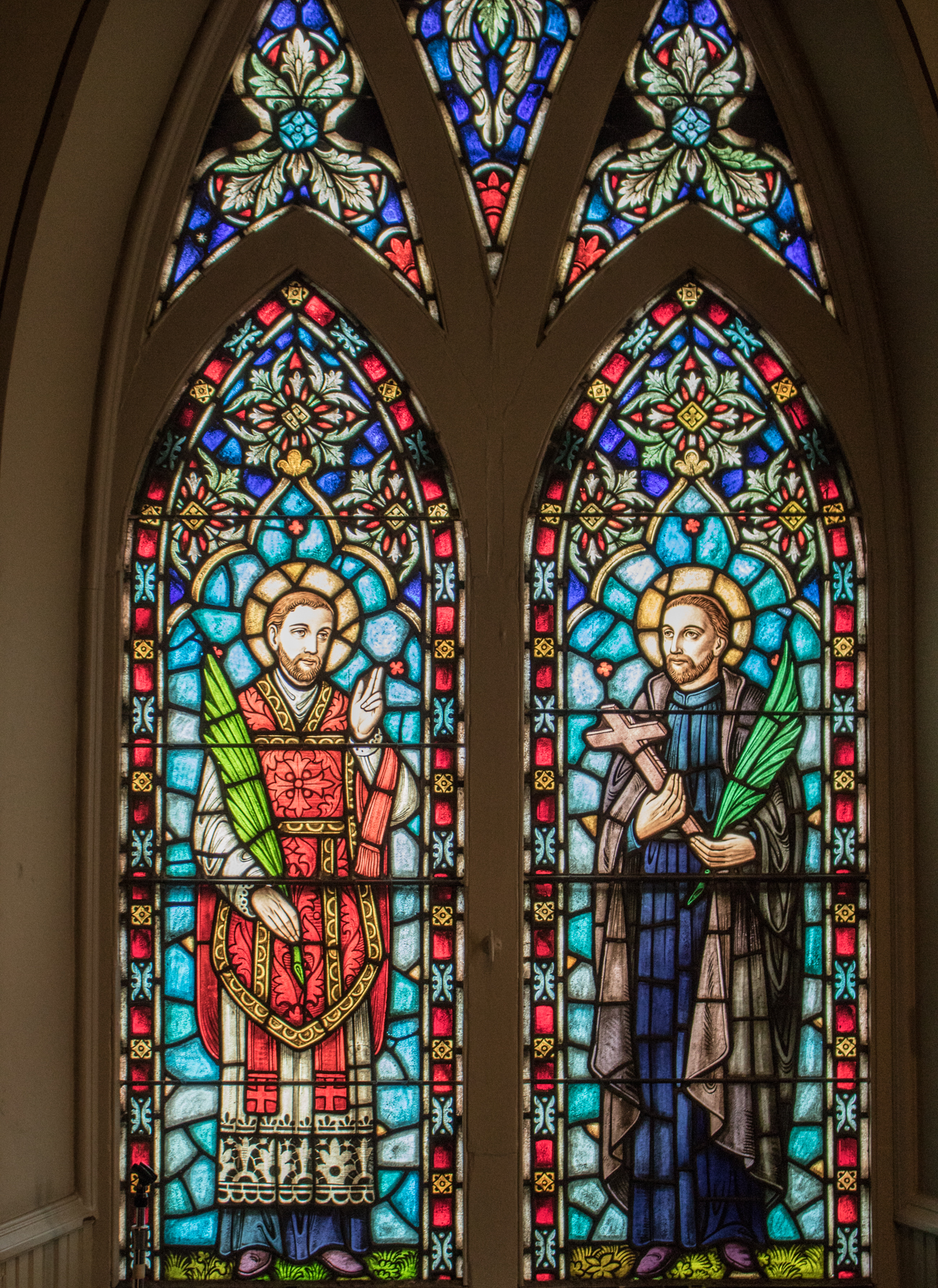 W18 – Saint Gabriel Lalemant and Saint Rene Goupil (Right side of Organ)
W18 – Saint Gabriel Lalemant and Saint Rene Goupil (Right side of Organ)
These windows were among those designed and installed in 1948. Dedicated to the memory of two of the great previous pastors, Reverend Monsignor Thomas A. Rankin, VG (1930 – 1942) and Reverend Monsignor Louis J. Smet (1915 – 1927), they present the other two Jesuit martyrs of North America. They were among the five windows that Reverend Monsignor Edward L. Stephens commissioned for the sesquicentennial (150th) anniversary of the founding of the parish.
 W19 – Double Decorative Window
W19 – Double Decorative Window
These windows are located on the North Wall of the Choir Loft, opposite the Organ and the windows of Saints Gabriel Lalemant and Rene Goupil. Banded in gold stained glass, they depict a banded and bordered lattice work pattern with insets at the bottom and the top of the Gothic arches.
